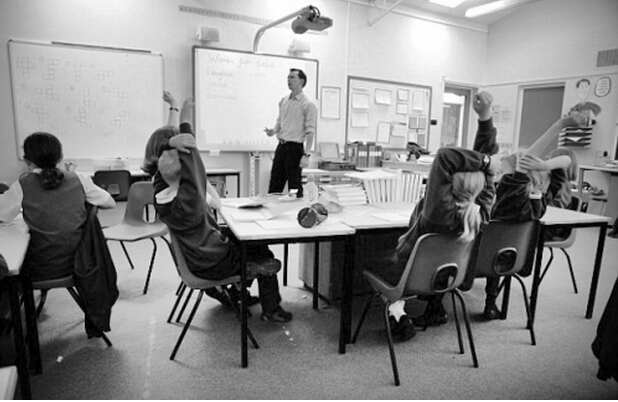2015-11-27 18:10:56阅读:97

一项国际研究发布警示,由于按照学生成绩进行分班,很多英国小学陷入到消极影响的循环当中。
Thousands of UK primary schools are locking their pupils into a cycle of disadvantage by separating them into ability groups a major international study has warned.
“在早期教育中,
被按照学习成绩进行分班的学生,
今后可能会表现平平。”
根据英国著名报纸《卫报》报道,经济合作与发展组织对39个发达国家的教育系统中的成功与失败做了详细调研。研究表明:在早期教育中,被按照学习成绩进行分班的学生,今后可能会表现平平。
教育分析专家Beatriz Pont,同时他也是经合组织调研报告的作者,表示:”早期根据学生的成绩分班教育,老师对成绩较差班级的同学并不寄予很大期望,也没有更高要求。”她补 充道:“这些学生通常在有机会开发自己的潜能之前已经被限制在一个水平比较低的教育环境里。”
According to respected UK newspaper The Guardian the Organisation for Economic Co-operation and Development (OECD) analysed successes and failures in education systems in 39 of the world’s most developed nations and the study has found that countries that stream pupils into ability groups at an early age tend to have lower levels of achievement.
Beatriz Pont an education analyst and one of the authors of the OECD’s study said streaming by ability at an early age “fuelled a vicious cycle” in which teachers had low expectations of students in the lowest sets. These students were often “locked into a lower educational environment before they had a chance to develop their potential” she said.

”英国读书能力较差的孩子的比例
比其他同等水平国家要高。“
二十世纪四十年代和五十年代初期,在英国根据学生成绩进行分班是很普遍的现象。直到二十世纪九十年代初,这种现象基本消失,由于研究显示这对学生的学习成果没有任何帮助。随后,根据学生成绩进行分班教育又逐渐被引入到英国学校。
经合组织的报告显示,英国读书能力较差的孩子的比例比其他同等水平国家要高。在英国,15岁不具备基本读书技能的孩子占18%。这个比例在经济合作与发展 组织的国家里属于平均水平,但是很多国家这项指标明显低于英国。芬兰,挪威,瑞典分别是8%,15%和17%。在上海,15岁不具备基本读书技能的孩子只 占4%。
在英国,25到34岁的人群里,有18%没有完成中学学习。在加拿大,美国和德国,该比例分别为8% 12% 和14%。
Dividing pupils into ability groups was common place in the UK in the 1940s and early 1950s. By the early 1990s it had virtually disappeared because studies had shown it had no effect on over all attainment. It is gradually being re-introduced into UK schools.
The OECD study also shows the UK has a higher proportion of pupils with poor reading skills than our rival nations. In the UK 18% of 15-year-olds do not have basic reading skills. This is average for OECD countries but several countries have considerably lower proportions than we do. Finland Norway and Sweden have 8% 15% and 17% respectively while Shanghai-China– which have been grouped together for the purpose of the study – only had 4%.
Almost a fifth– 18% – of 25 to 34-year-olds in the UK did not complete the last years of secondary school. In Canada the US and Germany the figures were 8% 12% and 14% respectively.
“合理的分班
可以在教学中做到因材施教。”
英国教育部的发言人说:“ 学校可以决定什么时候和怎样根据学生的成绩进行分班。” 研究显示,合理的分班可以在教学中做到因材施教。
如果不是基于对孩子成绩精确的分析而进行分班,或是分班的目的不是为了满足孩子个性化需求,那么分班是具有争议性的,并且会限制孩子的发展志向。
作为西方教育尤其是澳洲教育的代表,黑利伯瑞国际学校提供了一种范例,采用混合分班模式,并以小班授课,标准人数被控制在24人以内。校长尼古拉斯·杜瓦尔认为“这样做的最大好处,是老师可以关注到每一个学生,便于依据学生的能力与水平,量身定制个性化的学习计划。
A spokesman from the Department for Education said it was for schools to decide how and when to group and set pupils by ability. “Research shows that when setting is done well it can be an effective way to personalise teaching and learning to the differing needs of groups of pupils” he said.
“When setting is not d on accurate assessment of ability or isn’t used to adapt teaching to the needs of the group then it can be divisive and limit pupils’ aspirations.”
As a typical example of Western education especially Australian education Haileybury International School provides a model of mixed class grouping and gives lessons in small-size classes with standard number of less than 24 students. President Nicolas Duval believes that ” the biggest advantage of this model is the teacher can focus on each student and make tailored learning solution d on their diversified ability and level.”